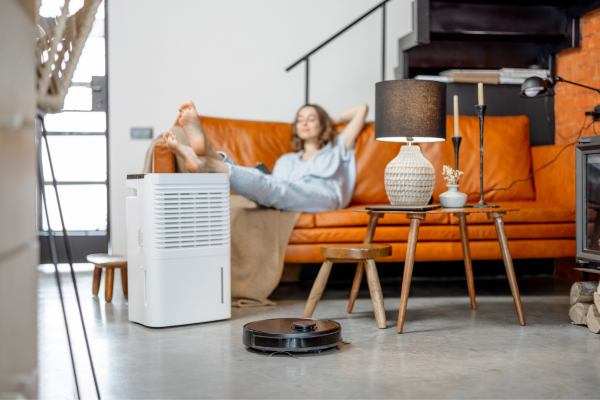Are you aware of the impact that indoor air quality can have on your health?
In this article, we will delve into the world of indoor air pollution and its potential consequences on respiratory health.
We will explore common sources of indoor air pollutants and provide strategies to improve the quality of the air you breathe.
With a focus on ventilation, we will highlight the importance of maintaining healthy indoor air and provide you with the knowledge to create a safe and comfortable environment where you truly belong.

Key Takeaways
- Indoor air pollution can come from various sources such as tobacco smoke, cleaning products, building materials, and outdoor pollutants.
- Breathing in indoor air pollutants can cause short-term symptoms like coughing and wheezing, as well as long-term health issues including respiratory diseases, heart problems, and cancer.
- Enhancing ventilation through practices like opening windows, using exhaust fans, and installing mechanical ventilation systems can help improve indoor air quality.
- Proper ventilation and cleanliness are essential for maintaining a healthy indoor environment and reducing the accumulation of harmful substances like dust, pet dander, and allergens.
Understanding Indoor Air Pollution
You need to understand indoor air pollution and its effects on your health.
Indoor air pollution refers to the presence of harmful pollutants in the air within buildings or enclosed spaces. These pollutants can come from various sources such as tobacco smoke, household cleaning products, building materials, and outdoor pollutants that enter the building.
Breathing in these pollutants can have detrimental effects on your health, ranging from short-term symptoms like irritation of the eyes, nose, and throat, to long-term effects like respiratory diseases, heart problems, and even cancer.
To ensure a healthy indoor environment, it is important to identify and eliminate potential sources of pollution, improve ventilation, and maintain a clean living space. By being aware of indoor air pollution and taking necessary steps, you can create a safe and healthy environment for yourself and your loved ones.
Common Sources of Indoor Air Pollutants
Dust, pet dander, and mold are common sources of indoor air pollutants. These substances can have a significant impact on the quality of the air you breathe inside your home. To better understand the potential health risks associated with these pollutants, it’s important to consider their sources and take appropriate measures to minimize their presence.
Here are two sub-lists that will help you identify and address these common sources of indoor air pollutants:
Dust:
- Carpets and rugs: Regular vacuuming and deep cleaning can help reduce dust accumulation.
- Furniture: Dusting and using furniture polish can help keep dust particles at bay.
Pet dander:
- Regular grooming: Brushing and bathing your pets can help minimize the amount of dander they shed.
- Air purifiers: Investing in an air purifier with a HEPA filter can help remove pet dander from the air.
By being aware of these sources and taking proactive steps to mitigate them, you can create a healthier indoor environment for yourself and your loved ones.
The Impact of Poor Indoor Air Quality on Respiratory Health
The impact of poor indoor air quality on respiratory health can be significant. When we breathe in polluted air, it can irritate our respiratory system, leading to symptoms such as coughing, wheezing, and shortness of breath. Long-term exposure to indoor air pollutants can even increase the risk of developing respiratory diseases like asthma and chronic obstructive pulmonary disease (COPD).
Indoor air pollutants, such as tobacco smoke, mold, and pet dander, can trigger inflammation in the airways, making it harder for us to breathe. Additionally, chemical pollutants from household products and building materials can release harmful gases, further compromising our respiratory health.
To improve indoor air quality and protect our respiratory health, it is important to ventilate our homes properly, avoid smoking indoors, and regularly clean and maintain our HVAC systems. By taking these steps, we can create a healthier indoor environment and reduce the risk of respiratory problems.
Strategies for Improving Indoor Air Quality
To improve your home’s air quality and protect your respiratory system, it’s important to implement strategies such as proper ventilation, avoidance of smoking indoors, and regular maintenance of HVAC systems. These measures can significantly reduce the presence of indoor air pollutants and create a healthy living environment for you and your loved ones.
Here are two key strategies for improving indoor air quality:
Enhance ventilation:
- Open windows and doors whenever possible to let fresh air circulate.
- Use exhaust fans in kitchens and bathrooms to remove moisture and airborne contaminants.
Minimize indoor pollutants:
- Avoid smoking indoors, as secondhand smoke contains harmful chemicals.
- Regularly clean and vacuum your home to remove dust, pet dander, and other allergens.
By following these strategies, you can ensure that your home provides a safe and comfortable space, promoting good respiratory health and a sense of belonging for all who reside within it.
The Importance of Ventilation in Maintaining Healthy Indoor Air
Enhancing ventilation is crucial for maintaining a healthy indoor environment. Proper ventilation helps to remove pollutants and improve air quality, which is essential for your well-being.
When indoor air is stagnant, it can become filled with harmful substances such as volatile organic compounds (VOCs), allergens, and other contaminants. These pollutants can lead to a variety of health issues, including respiratory problems, allergies, and even asthma.
By increasing the flow of fresh air into your space, you can dilute and flush out these harmful substances, reducing the risk of health problems. Opening windows, using exhaust fans, and installing mechanical ventilation systems are effective strategies for improving indoor air quality.
Remember, good ventilation not only helps to maintain a healthier environment but also creates a sense of comfort and belonging in your home or workplace.
Frequently Asked Questions
Can poor indoor air quality affect other aspects of our health besides respiratory health?
Poor indoor air quality can indeed have a significant impact on various aspects of your health beyond just respiratory health. It can lead to issues such as allergies, skin irritations, headaches, fatigue, and even affect your cognitive function and overall well-being.
Are there any natural sources of indoor air pollutants?
Yes, there are natural sources of indoor air pollutants. These include pet dander, pollen, mold spores, and volatile organic compounds emitted by plants and trees. It is important to be aware of these sources and take necessary steps to improve indoor air quality.
How can I determine the indoor air quality in my home?
To determine the indoor air quality in your home, you can use various methods such as conducting air quality tests, monitoring humidity levels, checking for mold and allergens, and ensuring proper ventilation.
What are some common misconceptions about improving indoor air quality?
Some common misconceptions about improving indoor air quality include believing that simply opening windows is enough, thinking that air fresheners are effective, and assuming that dusting and vacuuming alone will solve the problem.
Are there any long-term health effects associated with exposure to indoor air pollutants?
Long-term exposure to indoor air pollutants can lead to a range of health effects, such as respiratory diseases, cardiovascular issues, and even cancer. It is essential to improve indoor air quality to mitigate these risks and promote a healthier living environment.
Conclusion
In conclusion, it is crucial to prioritize indoor air quality for the sake of your health. Understanding the sources of indoor air pollutants is the first step in combating this issue.
Poor indoor air quality can have detrimental effects on respiratory health, leading to various respiratory diseases. Implementing strategies such as proper ventilation can significantly improve indoor air quality.
By being aware of these factors and taking appropriate measures, you can ensure a healthier living environment for yourself and your loved ones.


